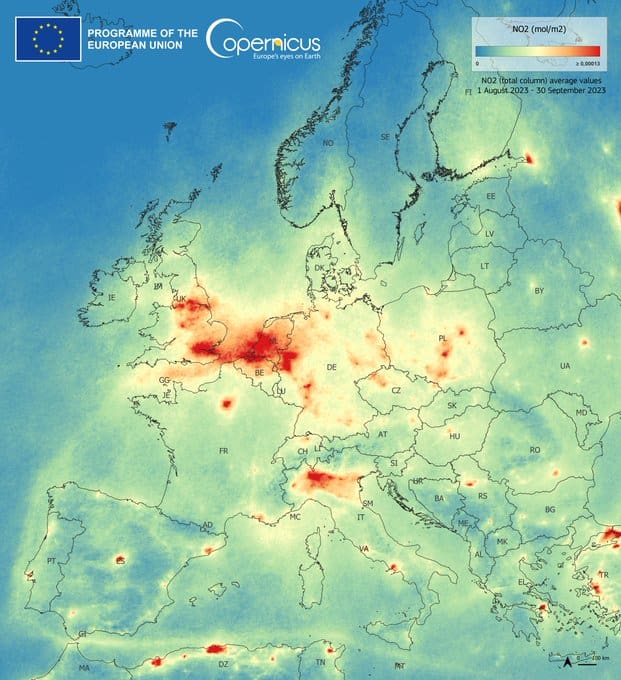
Copernicus Sentinel-5P, a collaboration between the ESA and the European Commission, has been monitoring atmospheric gases since 2017, with a particular focus on nitrogen dioxide. A recent image reveals concerning concentrations of NO2 above the UK, Belgium, and the Netherlands. The Sentinel-5P mission, equipped with the TROPOspheric Monitoring Instrument, surpasses its predecessors in sensitivity, resolution, and coverage. The Netherlands has been struggling to limit nitrogen emissions since 2019. The latest satellite data suggest that efforts to reduce nitrogen emissions have had limited success thus far. Copernicus Sentinel-5P continues to provide crucial data on atmospheric conditions, informing key decisions regarding air quality management and climate change.
- Sentinel-5P monitors NO2 levels, revealing high concentrations above the UK, Belgium, and the Netherlands, indicating emission challenges.
- Netherlands faces complications in managing nitrogen emissions, causing delays in construction and industry uncertainty.
- High NO2 concentrations pose health and environmental risks, emphasizing the need for effective emissions regulations.
The Role of Sentinel-5P in monitoring atmospheric gases
Launched in 2017, the Sentinel-5P satellite is part of the European Space Agency’s Copernicus Programme. Its purpose is to monitor the atmosphere, particularly looking at the concentration of key pollutants. Among these pollutants, nitrogen dioxide (NO2) is one of the most harmful to both the environment and human health. NO2 emissions primarily come from burning fossil fuels in energy production, industry, and transport.

The Sentinel-5P satellite is equipped with the Tropospheric Monitoring Instrument (Tropomi), providing it with unparalleled sensitivity, resolution, and coverage. This allows it to monitor a wide range of atmospheric gases, including methane, sulphur dioxide, and, notably, nitrogen dioxide. By providing high-resolution maps of atmospheric gases, the Sentinel-5P aids in understanding and managing air quality and climate change.
A recent image captured by the Sentinel-5P revealed alarming concentrations of NO2 above the UK, Belgium, and the Netherlands. This data suggests that efforts to reduce nitrogen emissions in these countries have had limited success thus far.
The struggle to reduce nitrogen emissions in the Netherlands
In the Netherlands, the nitrogen crisis is complicated by the rulings on the Programma Aanpak Stikstof (PAS) in 2019. The PAS, which allowed advance permission for activities based on anticipated future positive effects on protected nature areas, was deemed insufficiently substantiated by the country’s highest court, the Raad van State. Now, permits for activities like grazing and fertilizing also require a separate nitrogen emissions calculation.
The increase in nitrogen emissions calculations has led to significant delays in construction projects and increased uncertainty in the industry. More recently the Raad van State, ruled that construction projects could no longer proceed under the “bouwvrijstelling” loophole, which allowed them to go ahead despite the potential for nitrogen emissions.

Each construction project now requires a separate nitrogen emissions calculation, which could cause delays of six to nine months due to a shortage of experts. If excessive nitrogen emissions are discovered near Natura 2000 areas, the construction permits could be at risk. With the revocation of the bouwvrijstelling and PAS, the NEPROM, the lobby organization for project developers, has criticized the government’s slow response to the crisis. The situation in the Netherlands exemplifies the ongoing challenges of formulating a practical nitrogen policy that effectively balances environmental considerations.
Implications of high nitrogen dioxide concentrations
Nitrogen dioxide is a significant air pollutant and a primary contributor to acid rain, which can have adverse effects on soil, water quality, and biodiversity. High concentrations of NO2 in the air can lead to inflammation of the airways, posing a significant risk to human health. NO2 also contributes to the formation of secondary particulate aerosols and tropospheric ozone, both harmful air pollutants.

The data from Sentinel-5P serves as a stark reminder of the urgency and scale of the challenge facing European countries in their attempts to manage air quality and combat climate change. The high concentrations of nitrogen dioxide in the atmosphere above the UK, Belgium, and the Netherlands underline the importance of effective and enforceable emissions regulations. As the Sentinel-5P continues its mission, it will provide crucial data for policymakers and stakeholders in their fight against climate change.








